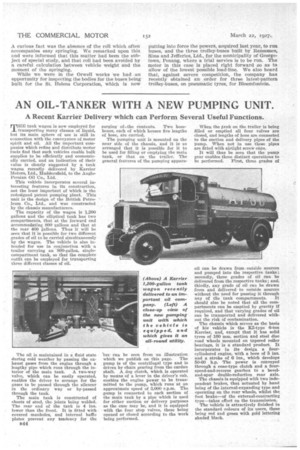AN OIL-TANKER WITH A NEW PUMPING UNIT.
Page 70

If you've noticed an error in this article please click here to report it so we can fix it.
A Recent Karrier Delivery which can Perform Several Useful Functions.
THE tank wagon is now employed for transporting many classes of liquid, but its main sphere of use is still in connection with the conveyance of motor spirit and oil. All the important companies which refine and distribute motor fuels find that such vehicles enable bulk supplies to be efficiently and economically carried, and an indication of their value is dearly suggested by a tank wagon recently delivered by Karrier Motors, Ltd., Huddersfield, to the Anglo
Persian Oil Co., Ltd.. • This vehicle incorporates several interesting features in its construction, net the least important of which is the redesigned patent pumping plant. This unit is the design of the British Petroleum Co., Ltd., and was constructed by the chassis manufacturers.
The capacity of the wagon is 1,200 gallons and the elliptical tank has two compartments, that at the forward end accommodating 800 gallons and that at the rear 400 kallons. Thus it will be seen that it is possible for two different grades of oil to be carried simultaneously by the wagon. The vehicle is also intended for use in conjunction with a trailer carrying an 800-gallon, singlecompartnaent tank, so that the complete outfit can be employed for transporting three different classes of oil.
The oil is maintained in a fluid state during cold weather by passing the exhaust gases from the engine through a lengthy pipe which runs through the interior of the main tank. A two-way valve, which can be easily operated, enables the driver to arrange for the gases to be passed through the silencer in the ordinary way or by-passed through the tank.
The main tank is constructed of sheets of steel, the joints being welded. The rear end of the tank is 4 ins. lower than the front. It is fitted with • covered • manholes, and internal baffle plates prevent any tendency for thc surging of-the contents. Two hose boxes, each of which houses five lengths of hose, are carried.
The pumping unit is mounted on the near side of the chassis, and it is so arranged that it is possible for it to be used for filling or emptying the main tank, or that on the trailer. The general features of the pumping appara
Ins Can be seen from au illustration which we publish on this page. The pump is of the centrifugal type and is driven by chain gearing from the eardan shaft. A dog clutch, which is operated by means of a lever in the driver's cab, enables the engine power to be transmitted to the pump, which runs at an approximate speed of 3,000 r.p.ra. The pump is connected to each section of the main tank by a pipe which is used for either suction or delivery purposes as the ease may be, and it is equipped with the four stop valves, these being opened or closed according to the work being performed. When the tank on the trailer is being filled or emptied all four valves are closed, and lengths of hose are connected to the s-uction and delivery pipes of the pump. When not in use these pipes are fitted with airtight screw caps.
It will thus be seen that the pump gear enables three distinct operations to be performed. First, three grades of oil can be drawn from outside sources and pumped into the respective tanks ; secondly, three grades of oil can be delivered from the respective tanks; and, thirdly, any grade of oil can be drawn from and delivered to outside sources without the need for passing it through any of the tank compartments. It should also be noted that all the compartments can be emptied by gravity if required, and that varying grades of oil can be transported and delivered without the risk of contamination.
The chassis which serves as the basis of his vehicle is the K5-type 6-ton Karrier, and, except that it has solid tyres of 160 mm. section and steel disc road wheels mounted on tapered roller bearings, it is a standard product. It incorporates in its design a fourcylindered engine, with a bore of 5 ins. and a stroke of 6 ins., which develops 50-60 h.p. The power is conveyed through a cone-type dutch and a fourspeed-and-reverse gearbox to a beveland-spur double-reduction rear axle.
The chassis is equipped with two independent brakes, that actuated by hand being of the internal-expanding type and operating on the rear wheels, whilst the foot brake—of the external-contracting type—takes effect on the transmission.
The vehicle is attractively finished in the standard colours of its users, these being red and green with gold lettering shaded black.




















































































































